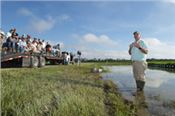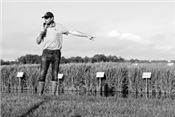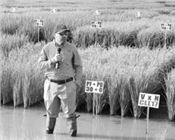Rice Researchers Highlight Variety Development, Growing Methods At 112th Annual Field Day
CROWLEY, LA.
More than 400 rice producers and industry insiders gathered for the first post-pandemic field day at the LSU AgCenter H. Rouse Caffey Rice Research Station on June 30.
Following a virtual field day in 2020, this year’s in-person event featured a field tour highlighting new developments in rice varieties, pest management and growing practices.
“We have had a great turnout for our first post-pandemic LSU AgCenter rice field day,” said Dustin Harrell, resident coordinator of the Rice Research Station. “We can once again give our rice growers and rice industry professionals an in-person look at our collaborative research efforts to create new varieties and best management practices for a thriving and sustainable rice crop here in Louisiana.”
For more than a century, rice growers have heard from researchers on how to produce a thriving crop at this annual event.
“We saw today some fabulous research from the staff and faculty at the Rice Research Station,” said Richard Fontenot, chairman of the Louisiana Rice Research Board and Evangeline Parish farmer. “We shared some of the research that we’re doing with the breeding program because we are looking at different varieties. A lot of our challenges, as we move forward today, is to offer what our customers and consumers want in Louisiana, in the United States and around the world.”
Faculty and staff at the station work year-round developing new varieties and growing techniques that are used across the state and beyond to produce an abundant and sustainable crop.
Adam Famoso, AgCenter rice breeder, talked about a new rice variety called PVL03 that has many positive characteristics, including resistance to blast disease.
“Our growers don’t get paid on how resistant a line is, but they’re paid on yield and quality,” Famoso said. “And disease is a major factor in determining what a given field or variety is going to do in terms of yield and quality.”
Harrell told participants of the field tours about growing rice using furrow irrigation, a practice that is growing in popularity.
“It’s basically growing rice in upland conditions,” Harrell said.
“We’re actually digging furrows and then we’re irrigating down those furrows with poly-pipe. Furrow-irrigated rice is really taking off in Arkansas and Mississippi, but also in northeast Louisiana.”
Harrell said this new growing method – also known as row rice – helps conserve water, fuel and manpower when compared to producing a crop with traditional growing methods. To attempt to overcome some of the challenges farmers may face with row rice, Harrell and his staff have implemented field trials to further examine nitrogen fertilization practices.
Mike Strain, commissioner of the Louisiana Department of Agriculture and Forestry, touted strong economic numbers for the nation’s agriculture sector. He said the U.S. economy regressed about 2.5 percent while the agricultural economy grew 4.6 percent within the past year.
“We are making more exports, so it’s driving our numbers,” Strain told the group. “We’ve seen over the last 18 months an increase in the value of our commodities by almost 60 percent.”
To outline some of the inner workings of the international rice trade, Betsy Ward, CEO of the USA Rice Federation, addressed the crowd. She detailed some of the challenges that her organization is working to overcome in the global rice market — including political unrest in Haiti that could lead to food shortages in that nation and a record rice crop in Colombia that is creating export losses for the U.S. rice industry.
“Whether it’s trade wars, multiple hurricanes or the pandemic, we certainly are cognizant of the challenges that you are facing,” Ward said. “It’s been a really trying couple of years, but the fact that we are all here gives me optimism for our rice industry and for our whole country.”
Though obstacles such as the tumultuous 2020 Atlantic hurricane season and the COVID-19 pandemic may have challenged the nation’s agriculture sector, the AgCenter remains dedicated to continuing the vital research conducted at the Rice Research Station and other facilities, said LSU AgCenter Vice President for Agriculture Bill Richardson.
“We continue your research in spite of some very, very difficult circumstances,” Richardson said. “We try to pay close attention to the needs of the rice industry. We want to make sure we move toward the future and provide you the quality of programs that you need to have.”
Richardson added that the rice farmers of Louisiana have funneled more than $40 million into research conducted at the Rice Research Station.
Other speakers at the event included state Rep. Clay Schexnayder, speaker of the Louisiana House of Representatives; Kurt Guidry, LSU AgCenter Southwest Region director; Kevin Norton, former assistant chief of the U.S. Department of Agriculture Natural Resources Conservation Service; and Mike Salassi, AgCenter associate vice president. ∆

LSU AgCenter weed scientist Eric Webster discusses his research during the 112th annual field day at the LSU AgCenter H. Rouse Caffey Rice Research Station on June 30.
Photo by Olivia McClure/LSU AgCenter

LSU AgCenter rice breeder Adam Famoso speaks at the 112th annual field day at the LSU AgCenter H. Rouse Caffey Rice Research Station on June 30. He is standing in front of a plot of PVL03, a new variety.
Photo by Olivia McClure/LSU AgCenter

Dustin Harrell, resident coordinator of the LSU AgCenter H. Rouse Caffey Rice Research Station, speaks to attendees of the facility’s 112th annual field day on June 30.
Photo by Derek Albert/LSU AgCenter